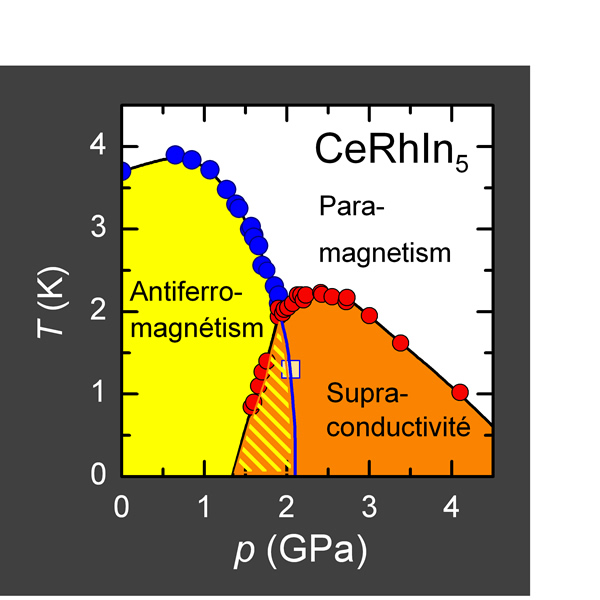


Heavy fermions are intermetallic alloys containing rare earth atoms (Cerium) or actinides (Uranium). The electrons at the “bottom” of these atoms give heavy fermions their amazing properties, especially thanks to their magnetism. Indeed, thanks to a quantum process, these electrons mix (hybridisation) with passing electrons to form a new particle - a type of electron characterized by the presence of all the others. These new particles, fermions, are strongly slowed down and behave as heavier particles, as if they were stuck in a huge electron traffic jam.
Researchers study these compounds because as it is the case in high-temperature superconductors, two states of matter meet: magnetism and superconductivity, with strong interactions between them. We strongly believe that magnetism is the “glue” enabling the association of electrons in pairs in these compounds, thus enabling superconductivity. Paradoxically, the fact that these striking properties only appear at a very low temperature is an advantage to understand fundamental physics, and heavy fermions make an excellent testing ground for understanding the properties of other kinds of superconductors.
In addition to that, some very surprising phenomena in heavy fermions’ superconductivity have been discovered. Thus, coexistence of ferromagnetism and superconductivity was discovered in the UGe2 compound. In some heavy-fermion compounds, superconductivity, which should be destroyed by the magnetic field, survives extraordinarily strong magnetic fields compared to the critical temperature. Sometimes, we even witness a surprising phenomenon: superconductivity appears when a strong magnetic field is applied. These properties can only be explained by the existence of an unusual superconducting phase that we can theoretically predict: the spins (the small magnet carried by each electron) of the electrons forming Cooper pairs point towards the same direction whereas they normally point towards opposite directions. This is called “triplet superconductivity”. So far, this phenomenon has only been observed in a superfluid helium-3.
 One of the techniques used by researchers to understand these unusual properties is to apply very strong pressures on the materials, up to 100 000 times stronger than the atmospheric pressure. Indeed, pressure leads to major changes in heavy fermions, the same way doping does in cuprates. For instance, we can destroy magnetism and make superconductivity appear in order to study the small zone where they both coexist. Click on the figure to change the pressure and make the strong links between superconductivity and magnetism appear in the CeRhIn5 compound.
One of the techniques used by researchers to understand these unusual properties is to apply very strong pressures on the materials, up to 100 000 times stronger than the atmospheric pressure. Indeed, pressure leads to major changes in heavy fermions, the same way doping does in cuprates. For instance, we can destroy magnetism and make superconductivity appear in order to study the small zone where they both coexist. Click on the figure to change the pressure and make the strong links between superconductivity and magnetism appear in the CeRhIn5 compound.
